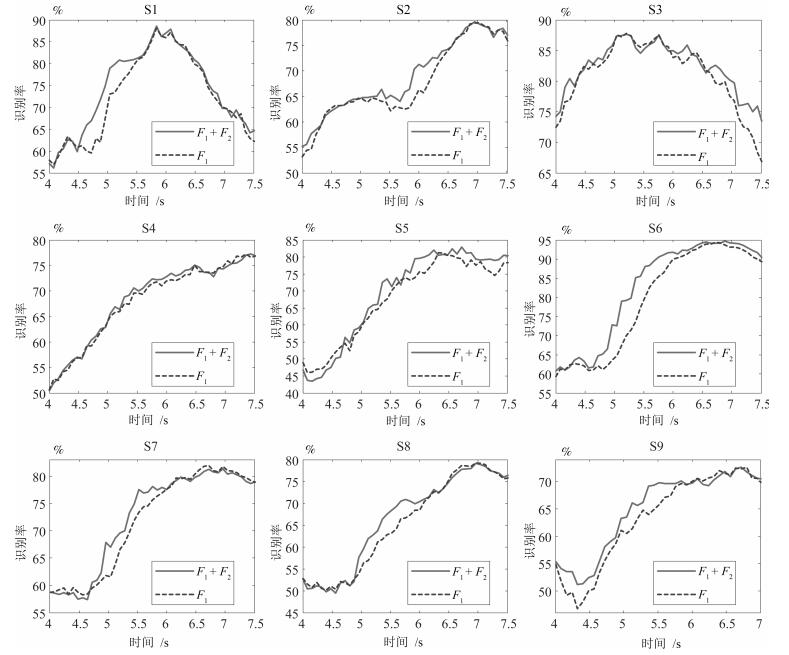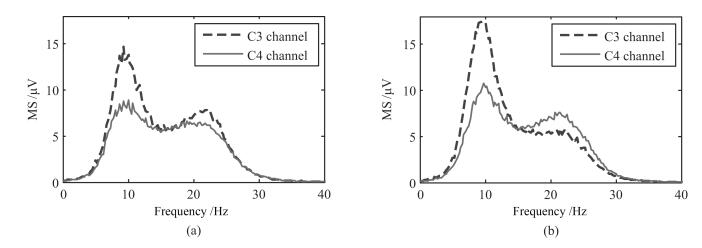Multiple Feature Extraction Based on Ensemble Empirical Mode Decomposition for Motor Imagery EEG Recognition Tasks
-
摘要: 人的脑电信号(Electroencephalogram,EEG)复杂且具有非线性及非平稳性的特点使其不易分析处理,其识别效果也依赖于数据集的不同,而表现不稳定.本文中应用的总体经验模态分解(Ensemble empirical mode decomposition,EEMD)是一种具有强自适应性的信号处理方法,其在时频域展现的良好分辨率特别适合脑电识别任务处理.本文提出利用EEMD分解后得到的较具影响能力的固有模态函数(Intrinsic mode functions,IMFs),利用希尔伯特变换提取边际谱(Marginal spectrum,MS)及瞬时能谱(Instantaneous energy spectrum,IES)时频特征,同时通过加窗的方法提取非线性动力学特征近似熵特征,利用线性判别分类器(Linear discriminant analysis,LDA)作为分类器,实验结果得出,对于被试S2和被试S3可达到识别率分别为79.60%和87.77%,实验中9名被试的平均识别率为82.74%,得到平均识别率也高于近期使用相同数据集文献的其他方法.Abstract: EEG signals are complicated as well as nonlinear and non-stationary, which make them hard to analyze. Recognition result is dependent on the datasets selected, and is not stable. The ensemble empirical mode decomposition (EEMD) as a kind of adaptive signal processing method is used for motor imagery recognition tasks because of its good decomposition resolution. An efficient EEMD-based feature extraction scheme is presented, which combines the Hilbert marginal spectrum (MS) and instantaneous energy spectrum (IES) features with window-added EEMD-based approximate entropy (ApEn) features. The impactful factors of IMFs and frequency bands are selected for the features as well. A linear discriminant analysis (LDA) classifier is designed for classifyication. The method is tested on nine subjects. The result shows that the proposed feature combination is competitive in recognition rate with other methods on the same dataset. The maximal classification accuracy for S2 and S3 can reach 79.60% and 87.77%, respectively. The mean accuracy of nine subjects is 82.74%. The average recognition rate obtained is superior to other methods on the same datasets.1) 本文责任编委 朱朝喆
-
表 1 不同被试采用两种特征在两类时段可获得的平均识别率和最高识别率
Table 1 The average and maximal classification accuracy obtained by different features F1 and F1 + F2
被试 特征组合 识别率上升时段 最优时段平均 最优时段最高 平均识别率(%) 识别率(%) 识别率(%) S1 F1 68.39 83.85 88.09 F1+F2 73.38 84.23 88.56 S2 F1 69.60 78.15 79.44 F1+F2 71.14 78.26 79.60 S3 F1 80.04 86.53 87.77 F1+F2 81.16 86.29 87.65 S4 F1 64.82 75.33 77.25 F1+F2 65.41 75.13 77.22 S5 F1 65.60 78.31 81.29 F1+F2 67.70 80.52 82.93 S6 F1 72.37 92.01 94.38 F1+F2 78.50 93.09 94.72 S7 F1 68.37 80.28 81.97 F1+F2 70.56 79.92 81.28 S8 F1 64.62 77.52 79.23 F1+F2 67.67 77.26 79.14 S9 F1 61.74 71.07 72.59 F1+F2 64.15 70.77 72.59 表 2 加窗ApEn和时间均值ApEn特征对于不同被试取得的识别率对比
Table 2 The comparasion of window-added ApEn feature and normal ApEn feature on accuracy for each subjects
被试 加窗ApEn (%) 时间均值的ApEn (%) S1 76.14±0.99 64.54±1.38 S2 74.14±0.40 72.86±0.61 S3 84.97±0.86 81.93±0.84 S4 60.02±0.80 59.03±0.42 S5 72.38±1.80 71.17±1.17 S6 84.58±0.28 82.58±0.46 S7 75.80±0.57 80.99±0.40 S8 75.00±0.57 73.88±0.39 S9 67.04±0.47 68.13±0.47 表 3 对于不同被试者可得到的最大识别率(%)
Table 3 The maximal classification accuracy (%) obtained on different subjects
表 4 本文方法与BCI竞赛获奖者所取得的最大互信息对比
Table 4 Comparison of maximal mutual information (MI) between our work and BCI competition winners'methods
特征提取方法 最大互信息(MI) Schäfer and Lemm Morlet小波特征 0.61 Narayanad AR功率谱 0.46 Saffari AAR参数模型 0.45 Gao 频段能量特征 0.44 Sadashivaiah 六阶AR参数模型 0.29 本文方法 0.64 表 5 本文中所用方法的时耗统计
Table 5 The time consumption of the method used in this paper
EEMD过程 瞬时能量特征 边际谱特征 近似熵特征 时耗(s) 1.147 0.001 0.082 2.354 -
[1] Wolpaw J R, Birbaumer N, Mcfarland D J, Pfurtscheller G, Vaughan T M. Brain-computer interfaces for communication and control. Clinical Neurophysiology, 2002, 113(6): 767-791 doi: 10.1016/S1388-2457(02)00057-3 [2] Birbaumer N. Breaking the silence: Brain-computer interfaces (BCI) for communication and motor control. Psychophysiology, 2006, 43(6): 517-532 doi: 10.1111/psyp.2006.43.issue-6 [3] 高上凯.浅谈脑--机接口的发展现状与挑战.中国生物医学工程学报, 2007, 26(6): 801-803, 809 http://www.cnki.com.cn/Article/CJFDTOTAL-ZSWY200706002.htmGao Shang-Kai. Comments on recent progress and challenges in the study of brain-computer interface. Chinese Journal of Biomedical Engineering, 2007, 26(6): 801-803, 809 http://www.cnki.com.cn/Article/CJFDTOTAL-ZSWY200706002.htm [4] 王行愚, 金晶, 张宇, 王蓓.脑控:基于脑--机接口的人机融合控制.自动化学报, 2013, 39(3): 208-221 http://www.aas.net.cn/CN/abstract/abstract17800.shtmlWang Xing-Yu, Jin Jing, Zhang Yu, Wang Bei. Brain control: Human-computer integration control based on brain-computer interface. Acta Automatica Sinica, 2013, 39(3): 208-221 http://www.aas.net.cn/CN/abstract/abstract17800.shtml [5] Blankertz B, Sannelli C, Halder S, Hammer E M, Kübler A, Müller K R, Curio G, Dickhaus T. Neurophysiological predictor of SMR-based BCI performance. Neuroimage, 2010, 51(4): 1303-1309 doi: 10.1016/j.neuroimage.2010.03.022 [6] Pfurtscheller G, Neuper C. Motor imagery and direct brain-computer communication. Proceedings of the IEEE, 2001, 89(7): 1123-1134 doi: 10.1109/5.939829 [7] Birbaumer N, Ghanayim N, Hinterberger T, Iversen I, Kotchoubey B, Kübler A, Perelmouter J, Taub E, Flor H. A spelling device for the paralysed. Nature, 1999, 398(6725): 297-298 doi: 10.1038/18581 [8] Bayliss J D. Use of the evoked potential P3 component for control in a virtual apartment. IEEE Transactions on Neural Systems and Rehabilitation Engineering, 2003, 11(2): 113-116 doi: 10.1109/TNSRE.2003.814438 [9] Hoffmann U, Vesin J M, Ebrahimi T, Diserens K. An efficient P300-based brain-computer interface for disabled subjects. Journal of Neuroscience Methods, 2008, 167(1): 115-125 doi: 10.1016/j.jneumeth.2007.03.005 [10] Lalor E C, Kelly S P, Finucane C, Burke R, Smith R, Reilly R B, McDarby G. Steady-state VEP-based brain-computer interface control in an immersive 3D gaming environment. EURASIP Journal on Applied Signal Processing, 2005, 2005: 3156-3164 doi: 10.1155/ASP.2005.3156 [11] Middendorf M, McMillan G, Calhoun G, Jones K S. Brain-computer interfaces based on the steady-state visual-evoked response. IEEE Transactions on Rehabilitation Engineering, 2000, 8(2): 211-214 doi: 10.1109/86.847819 [12] Hwang H J, Kwon K, Im C H. Neurofeedback-based motor imagery training for brain-computer interface (BCI). Journal of Neuroscience Methods, 2009, 179(1): 150-156 doi: 10.1016/j.jneumeth.2009.01.015 [13] Tam W K, Tong K Y, Meng F, Gao S. A minimal set of electrodes for motor imagery BCI to control an assistive device in chronic stroke subjects: A multi-session study. IEEE Transactions on Neural Systems and Rehabilitation Engineering, 2011, 19(6): 617-627 doi: 10.1109/TNSRE.2011.2168542 [14] Pfurtscheller G. Functional brain imaging based on ERD/ERS. Vision Research, 2001, 41(10-11): 1257-1260 doi: 10.1016/S0042-6989(00)00235-2 [15] McFarland D J, Miner L A, Vaughan T M, Wolpaw J R. Mu and Beta Rhythm topographies during motor imagery and actual movements. Brain Topography, 2000, 12(3): 177-86 doi: 10.1023/A:1023437823106 [16] Chen M Y, Fang Y H, Zheng X F. Phase space reconstruction for improving the classification of single trial EEG. Biomedical Signal Processing and Control, 2014, 11: 10-16 doi: 10.1016/j.bspc.2014.02.002 [17] Rodríguez-Bermúdez G, Garcí a-Laencina P J, Roca-González J, Roca-Dorda J. Efficient feature selection and linear discrimination of EEG signals. Neurocomputing, 2013, 115: 161-165 doi: 10.1016/j.neucom.2013.01.001 [18] 孙会文, 伏云发, 熊馨, 杨俊, 刘传伟, 余正涛.基于HHT运动想象脑电模式识别研究.自动化学报, 2015, 41(9): 1686-1692 http://www.aas.net.cn/CN/abstract/abstract18742.shtmlSun Hui-Wen, Fu Yun-Fa, Xiong Xin, Yang Jun, Liu Chuan-Wei, Yu Zheng-Tao. Identification of EEG induced by motor imagery based on Hilbert-Huang transform. Acta Automatica Sinica, 2015, 41(9): 1686-1692 http://www.aas.net.cn/CN/abstract/abstract18742.shtml [19] Hsu W Y. Assembling a multi-feature EEG classifier for left-right motor imagery data using wavelet-based fuzzy approximate entropy for improved accuracy. International Journal of Neural Systems, 2015, 25(8): 1550037 doi: 10.1142/S0129065715500379 [20] Hsu W Y, Sun Y N. EEG-based motor imagery analysis using weighted wavelet transform features. Journal of Neuroscience Methods, 2009, 176(2): 310-318 doi: 10.1016/j.jneumeth.2008.09.014 [21] Wang H X. Optimizing spatial filters for single-trial EEG classification via a discriminant extension to CSP: The Fisher criterion. Medical & Biological Engineering & Computing, 2011, 49(9): 997-1001 https://www.researchgate.net/publication/50852065_Optimizing_spatial_filters_for_single-trial_EEG_classification_via_a_discriminant_extension_to_CSP_The_Fisher_criterion [22] 王金甲, 陈春.分层向量自回归的多通道脑电信号的特征提取研究.自动化学报, 2016, 42(8): 1215-1226 http://www.aas.net.cn/CN/abstract/abstract18911.shtmlWang Jin-Jia, Chen Chun. Multi-channel EEG feature extraction using hierarchical vector autoregression. Acta Automatica Sinica, 2016, 42(8): 1215-1226 http://www.aas.net.cn/CN/abstract/abstract18911.shtml [23] 杨帮华, 章云元, 何亮飞, 李华荣, 王倩.脑机接口中基于ICA-RLS的EOG伪迹自动去除.仪器仪表学报, 2015, 36(3): 668-674 http://www.cnki.com.cn/Article/CJFDTOTAL-YQXB201503024.htmYang Bang-Hua, Zhang Yun-Yuan, He Liang-Fei, Li Hua-Rong, Wang Qian. Removal of EOG artifacts from EEG signals in BCI based on ICA-RLS. Chinese Journal of Scientific Instrument, 2015, 36(3): 668-674 http://www.cnki.com.cn/Article/CJFDTOTAL-YQXB201503024.htm [24] He L H, Hu D, Wan M, Wen Y, von Deneen K M, Zhou M C. Common Bayesian network for classification of EEG-based multiclass motor imagery BCI. IEEE Transactions on Systems, Man, and Cybernetics: Systems, 2016, 46(6): 843-854 doi: 10.1109/TSMC.2015.2450680 [25] Yuksel A, Olmez T. A neural network-based optimal spatial filter design method for motor imagery classification. PLoS One, 2015, 10(5): e0125039 doi: 10.1371/journal.pone.0125039 [26] Wu Z H, Huang N E. Ensemble empirical mode decomposition: A noise-assisted data analysis method. Advances in Adaptive Data Analysis, 2011, 1(1): 1-41 https://www.researchgate.net/publication/282728306_Ensemble_empirical_mode_decomposition_A_noise-assisted_data_analysis_method [27] Huang N E, Shen Z, Long S R, Wu M C, Shih H H, Zheng Q A, Yen N C, Tung C C, Liu H H. The empirical mode decomposition and the Hilbert spectrum for nonlinear and non-stationary time series analysis. Proceedings of the Royal Society A: Mathematical, Physical and Engineering Sciences, 1998, 454(1971): 903-995 doi: 10.1098/rspa.1998.0193 [28] BCI Competition Ⅱ [Online], available: http://www.bbci.de/competition/ii/, May 5, 2017. [29] BCI Competition Ⅲ [Online], available: http://www.bbci.de/competition/iii/, May 5, 2017. [30] BCI Competition Ⅳ [Online], available: http://www.bbci.de/competition/iv/, May 5, 2017. [31] Pfurtscheller G, Neuper C. Event-related synchronization of mu rhythm in the EEG over the cortical hand area in man. Neuroscience Letters, 1994, 174(1): 93-96 doi: 10.1016/0304-3940(94)90127-9 [32] 罗磊, 黄博妍, 孙金玮, 温良.基于总体平均经验模态分解的主动噪声控制系统研究.自动化学报, 2016, 42(9): 1432-1439 http://www.aas.net.cn/CN/abstract/abstract18931.shtmlLuo Lei, Huang Bo-Yan, Sun Jin-Wei, Wen Liang. A new ANC system based on ensemble empirical mode decomposition. Acta Automatica Sinica, 2016, 42(9): 1432-1439 http://www.aas.net.cn/CN/abstract/abstract18931.shtml [33] Yeh C L, Chang H C, Wu C H, Lee P L. Extraction of single-trial cortical beta oscillatory activities in EEG signals using empirical mode decomposition. Biomedical Engineering Online, 2010, 9: 25 doi: 10.1186/1475-925X-9-25 [34] Pincus S M. Approximate entropy as a measure of system complexity. Proceedings of the National Academy of Sciences of the United States of America, 1991, 88(6): 2297-2301 doi: 10.1073/pnas.88.6.2297 [35] Srinivasan V, Eswaran C, Sriraam N. Approximate entropy-based epileptic EEG detection using artificial neural networks. IEEE Transactions on Information Technology in Biomedicine, 2007, 11(3): 288-295 doi: 10.1109/TITB.2006.884369 [36] Signorini M G, Magenes G, Cerutti S, Arduini D. Linear and nonlinear parameters for the analysis of fetal heart rate signal from cardiotocographic recordings. IEEE Transactions on Biomedical Engineering, 2003, 50(3): 365-374 doi: 10.1109/TBME.2003.808824 [37] Yu H, Yang J. A direct LDA algorithm for high-dimensional data with application to face recognition. Pattern Recognition, 2001, 34(10): 2067-2070 doi: 10.1016/S0031-3203(00)00162-X [38] Hariharan M, Fook C Y, Sindhu R, Ilias B, Yaacob S. A comparative study of wavelet families for classification of wrist motions. Computers & Electrical Engineering, 2012, 38(6): 1798-1807 http://profiles.wizfolio.com/Nazirah/publications/27945/183326/ [39] Schlögl A, Neuper C, Pfurtscheller G. Estimating the mutual information of an EEG-based brain-computer interface. Biomedizinische Technik. Biomedical Engineering, 2002, 47(1-2): 3-8 doi: 10.1515/bmte.2002.47.1-2.3 [40] 李明爱, 崔燕, 杨金福, 郝冬梅.基于HHT和CSSD的多域融合自适应脑电特征提取方法.电子学报, 2013, 41(12): 2479-2486 http://www.cnki.com.cn/Article/CJFDTOTAL-DZXU201312025.htmLi Ming-Ai, Cui Yan, Yang Jin-Fu, Hao Dong-Mei. An adaptive multi-domain fusion feature extraction with method HHT and CSSD. Acta Electronica Sinica, 2013, 41(12): 2479-2486 http://www.cnki.com.cn/Article/CJFDTOTAL-DZXU201312025.htm -





 下载:
下载:



